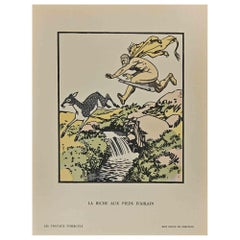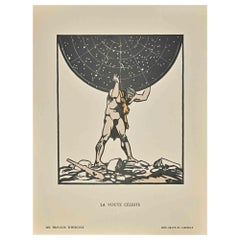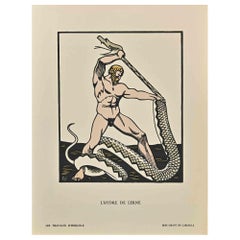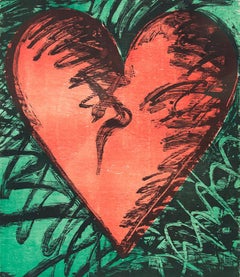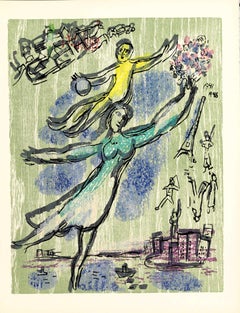Carlège
undefined
(Biography provided by Wallector)
to
1
9
7
7
7
2
2
Les Cavales de Diomède - Original Woodcut Print by Carlège (C.M. Egli)
Located in Roma, IT
Les Cavles de Diomède an Original Woodcut Print realized by Carlègle (Charles Emile Egli, 30 March 1877 – 11 January 1937).
Belong to the series "Les Travaux D'Hercule".
Good condition on a yellowed cardboard.
Titled, Stamp Signed on the lower margin
Charles Émile Egli (known as Carlègle; 30 March 1877 – 11 January 1937) was a Swiss-born illustrator and painter who spent most of his life in Paris. Charles Émile Egli was born in Aigle, Switzerland on 30 March 1877. He was educated in Aigle and then at the college of Vevey. When he was eighteen he attended engraving classes of Alfred Martin...
Category
Early 20th Century Modern Carlège
Materials
Woodcut
La Biche Aux Pieds D'Airain - Woodcut Print by Carlège (C.M. Egli)
Located in Roma, IT
La Biche Aux Pieds D'Airain is an Original Color Lithograph realized by Carlègle (Charles Emile Egli 30 March 1877 – 11 January 1937).
Belongs to the series ...
Category
1870s Modern Carlège
Materials
Woodcut
Le Lion De Némée - Original Woodcut Print by Carlège (C.M. Egli) - 1877
Located in Roma, IT
Le Lion De Némée is a Woodcut Print realized by Carlègle (Charles Emile Egli, 30 March 1877 – 11 January 1937).
Limited edition of 10 artwork unpublished Engraved Wood titled "Les T...
Category
1870s Modern Carlège
Materials
Woodcut
Le Sanglier D'Erymanthe - Original Woodcut Print by Carlège (C.M. Egli) - 1877
Located in Roma, IT
Le Sanglier D'Erymanthe a vintage color Woodcut Print realized by Carlègle (Charles Emile Egli, 30 March 1877 – 11 January 1937).
Belongs to the series "Les Travaux D'Hercule".
Goo...
Category
1870s Modern Carlège
Materials
Woodcut
La Voute Celeste - Original Woodcut Print by Carlège (C.M. Egli) - 1877
Located in Roma, IT
La Voute Celeste is an Original Color Woodcut Print realized by Carlègle (Charles Emile Egli, 30 March 1877 – 11 January 1937).
Belongs to the suite "Les Travaux D'Hercule".
Good condition on a yellowed cardboard.
Titled, Stamp Signed on the lower margin
Charles Émile Egli (known as Carlègle; 30 March 1877 – 11 January 1937) was a Swiss-born illustrator and painter who spent most of his life in Paris. Charles Émile Egli was born in Aigle, Switzerland on 30 March 1877. He was educated in Aigle and then at the college of Vevey. When he was eighteen he attended engraving classes of Alfred Martin...
Category
1870s Modern Carlège
Materials
Woodcut
L'Hydre De Lerne - Woodcut Print by Carlège (C.M. Egli)
Located in Roma, IT
L'Hydre De Lerne is a woodcut print realized by Carlègle (Charles Emile Egli, 30 March 1877 – 11 January 1937) in the Early 20th Century.
Belongs to the Suite "Les Travaux D'Hercule...
Category
1870s Modern Carlège
Materials
Woodcut
Le Taureau De L'Ile - Woodcut Print by Carlège (C.M. Egli) -Early 20th Century
Located in Roma, IT
Le Taureau De L'Ile De Crète is a a woodcut print realized by Carlègle (Charles Emile Egli) (30 March 1877 – 11 January 1937).
Part of the suite "Les Trav...
Category
Early 20th Century Modern Carlège
Materials
Woodcut
Cerbère - Original Woodcut Print by Carlège (C.M. Egli) - 1877
Located in Roma, IT
Cerbère is a Woodcut Print realized by Carlègle (Charles Emile Egli, 30 March 1877 – 11 January 1937).
Belongs to the Suite "Les Travaux D'Hercule".
Good condition on a yellowed cardboard.
Titled, Stamp Signed on the lower margin
Charles Émile Egli (known as Carlègle; 30 March 1877 – 11 January 1937) was a Swiss-born illustrator and painter who spent most of his life in Paris. Charles Émile Egli was born in Aigle, Switzerland on 30 March 1877. He was educated in Aigle and then at the college of Vevey. When he was eighteen he attended engraving classes of Alfred Martin...
Category
1870s Modern Carlège
Materials
Woodcut
Les Oiseaux Du Lac - Original Woodcut Print by Carlège (C.M. Egli) - 1877
Located in Roma, IT
Les Oiseaux Du Lac Stymphale is a Woodcut Print realized by Carlège (Charles Emile Egli, 30 March 1877 – 11 January 1937).
Belongs to the suite "Les Travaux D'Hercule".
Good condition on a yellowed cardboard.
Titled, Stamp Signed on the lower margin
Charles Émile Egli (known as Carlègle; 30 March 1877 – 11 January 1937) was a Swiss-born illustrator and painter who spent most of his life in Paris. Charles Émile Egli was born in Aigle, Switzerland on 30 March 1877. He was educated in Aigle and then at the college of Vevey. When he was eighteen he attended engraving classes of Alfred Martin...
Category
1870s Modern Carlège
Materials
Woodcut
Related Items
Rancho Woodcut Heart, 1982
By Jim Dine
Located in Palo Alto, CA
One of Jim Dine’s most iconic motifs, the romantic Rancho Woodcut Heart work illustrates the story of hope and love through a symbolic image of a large red heart. With the contrast o...
Category
1980s Modern Carlège
Materials
Woodcut
Répit, 1968 (Poèmes, #9)
By Marc Chagall
Located in Greenwich, CT
Répit (Respite) is a woodcut on paper from Marc Chagall's Poèmes portfolio, published in 1968. The image size is 13 x 10 inches and the art is framed in an ornate, gold-tone frame. U...
Category
20th Century Modern Carlège
Materials
Woodcut, Paper
'The Aquarium' — WPA Era 1930s Graphic Modernism
By Fritz Eichenberg
Located in Myrtle Beach, SC
Fritz Eichenberg, 'The Aquarium', wood engraving, 1933, edition 200. Signed and titled in pencil. Initialed in the block, lower right. A superb, richly-inked impression, on pale yel...
Category
1930s American Modern Carlège
Materials
Woodcut
'The Steps' — WPA Era 1930s Graphic Modernism
By Fritz Eichenberg
Located in Myrtle Beach, SC
Fritz Eichenberg, 'The Steps', wood engraving, 1933, edition 200. Signed, titled, and annotated 'Ed. 200' in pencil. Initialed in the block, lower right. A superb, richly-inked impr...
Category
1930s American Modern Carlège
Materials
Woodcut
'City Lights' — Vintage Wood Engraving, New York City, 1934
By Fritz Eichenberg
Located in Myrtle Beach, SC
Fritz Eichenberg, 'City LIghts', wood engraving, 1934, edition 200. Signed, titled 'Lights', and annotated 'No 2/200 for Howard M. Chapin' in pencil. Initialed in the block, lower right. A fine, richly-inked black impression, on cream wove paper, with full margins (1 1/4 to 1 7/8 inches); a small loss (5/8 inch) in the top right sheet corner, well away from the image, otherwise in excellent condition. Printed by master printer Ernest Roth...
Category
1930s American Modern Carlège
Materials
Woodcut
'Simplicius' Farewell to the World' — Graphic Modernism
By Fritz Eichenberg
Located in Myrtle Beach, SC
Fritz Eichenberg, 'Simplicius’ Farewell To The World' from the suite 'The Adventurous Simplicissimus', wood engraving, 1977, artist's proof apart from the edition of 50. Signed in pencil. Signed in the block, lower right. A fine, richly-inked impression, on cream wove paper, with full margins (1 1/2 to 2 inches), in excellent condition. Image size 14 x 12 inches (356 x 305 mm); sheet size 17 1/2 x 15 inches (445 x 381 mm). Archivally sleeved, unmatted.
ABOUT THIS WORK
'Simplicius Simplicissimus' (German: Der abenteuerliche Simplicissimus Teutsch) is a picaresque novel of the lower Baroque style, written in five books by Hans Jakob Christoffel von Grimmelshausen published in 1668, with the sequel Continuatio appearing in 1669.
The novel is told from the perspective of its protagonist Simplicius, a rogue or picaro typical of the picaresque novel, as he traverses the tumultuous world of the Holy Roman Empire during the Thirty Years' War. Raised by a peasant family, he is separated from his home by foraging dragoons. He is adopted by a hermit living in the forest, who teaches him to read and introduces him to religion. The hermit also gives Simplicius his name because he is so simple that he does not know his own name. After the death of the hermit, Simplicius must fend for himself. He is conscripted at a young age into service and, from there, embarks on years of foraging, military triumph, wealth, prostitution, disease, bourgeois domestic life, and travels to Russia, France, and an alternate world inhabited by mermen. The novel ends with Simplicius turning to a life of hermitage, denouncing the world as corrupt.
ABOUT THE ARTIST
Fritz Eichenberg (1901–1990) was a German-American illustrator and arts educator who worked primarily in wood engraving. His best-known works were concerned with religion, social justice, and nonviolence.
Eichenberg was born to a Jewish family in Cologne, Germany, where the destruction of World War I helped to shape his anti-war sentiments. He worked as a printer's apprentice and studied at the Municipal School of Applied Arts in Cologne and the Academy of Graphic Arts in Leipzig, where he studied under Hugo Steiner-Prag. In 1923 he moved to Berlin to begin his career as an artist, producing illustrations for books and newspapers. In his newspaper and magazine work, Eichenberg was politically outspoken and sometimes wrote and illustrated his reporting.
In 1933, the rise of Adolf Hitler drove Eichenberg, who was a public critic of the Nazis, to emigrate with his wife and children to the United States. He settled in New York City, where he lived most of his life. He worked in the WPA Federal Arts Project and was a member of the Society of American Graphic Artists.
In his prolific career as a book illustrator, Eichenberg portrayed many forms of literature but specialized in works with elements of extreme spiritual and emotional conflict, fantasy, or social satire. Over his long career, Eichenberg was commissioned to illustrate more than 100 classics by publishers in the United States and abroad, including works by renowned authors Dostoyevsky, Tolstoy, Charlotte and Emily Brontë, Poe, Swift, and Grimmelshausen. He also wrote and illustrated books of folklore and children's stories.
Eichenberg was a long-time contributor to the progressive magazine The Nation, his illustrations appearing between 1930 and 1980. Eichenberg’s work has been featured by such esteemed publishers as The Heritage Club, Random House, Book of the Month Club, The Limited Editions Club, Kingsport Press, Aquarius Press, and Doubleday.
Raised in a non-religious family, Eichenberg had been attracted to Taoism as a child. Following his wife's unexpected death in 1937, he turned briefly to Zen Buddhist meditation, then joined the Religious Society of Friends in 1940. Though he remained a Quaker until his death, Eichenberg was also associated with Catholic charity work through his friendship with Dorothy Day...
Category
1970s American Modern Carlège
Materials
Woodcut
'The Pimp' — Graphic Modernism
By Fritz Eichenberg
Located in Myrtle Beach, SC
Fritz Eichenberg, 'The Pimp', wood engraving, 1980, artist's proof before the edition. Signed in pencil. Signed in the block, lower right. A fine, richly-inked impression, on cream wove paper, with full margins (2 3/16 to 3 1/2 inches), in excellent condition. Archivally sleeved, unmatted.
Image size 12 x 9 3/4 inches (305 x 248 mm); sheet size 18 x 14 inches (457 x 356 mm).
ABOUT THE ARTIST
Fritz Eichenberg (1901–1990) was a German-American illustrator and arts educator who worked primarily in wood engraving. His best-known works were concerned with religion, social justice, and nonviolence.
Eichenberg was born to a Jewish family in Cologne, Germany, where the destruction of World War I helped to shape his anti-war sentiments. He worked as a printer's apprentice and studied at the Municipal School of Applied Arts in Cologne and the Academy of Graphic Arts in Leipzig, where he studied under Hugo Steiner-Prag. In 1923 he moved to Berlin to begin his career as an artist, producing illustrations for books and newspapers. In his newspaper and magazine work, Eichenberg was politically outspoken and sometimes wrote and illustrated his reporting.
In 1933, the rise of Adolf Hitler drove Eichenberg, who was a public critic of the Nazis, to emigrate with his wife and children to the United States. He settled in New York City, where he lived most of his life. He worked in the WPA Federal Arts Project and was a member of the Society of American Graphic Artists.
In his prolific career as a book illustrator, Eichenberg portrayed many forms of literature but specialized in works with elements of extreme spiritual and emotional conflict, fantasy, or social satire. Over his long career, Eichenberg was commissioned to illustrate more than 100 classics by publishers in the United States and abroad, including works by renowned authors Dostoyevsky, Tolstoy, Charlotte and Emily Brontë, Poe, Swift, and Grimmelshausen. He also wrote and illustrated books of folklore and children's stories.
Eichenberg was a long-time contributor to the progressive magazine The Nation, his illustrations appearing between 1930 and 1980. Eichenberg’s work has been featured by such esteemed publishers as The Heritage Club, Random House, Book of the Month Club, The Limited Editions Club, Kingsport Press, Aquarius Press, and Doubleday.
Raised in a non-religious family, Eichenberg had been attracted to Taoism as a child. Following his wife's unexpected death in 1937, he turned briefly to Zen Buddhist meditation, then joined the Religious Society of Friends in 1940. Though he remained a Quaker until his death, Eichenberg was also associated with Catholic charity work through his friendship with Dorothy Day...
Category
1980s American Modern Carlège
Materials
Woodcut
Divine Comedy : Hell 12, The Minotaure - Woodcut - 1963
By Salvador Dalí
Located in Paris, FR
Salvador Dali (1904-1989)
Hell 12 - The Minotaure
Woodcut
Printed signature in the plate 1960/63
Printed on paper Vélin BFK Rives
Size 32,8 x 26,4 cm (c. 13 x 10")
REFERENCES : Fi...
Category
1960s Modern Carlège
Materials
Woodcut
3 Jewish Men Judaica Woodblock Woodcut Engraving Print Chicago 1930s WPA Artist
By Todros Geller
Located in Surfside, FL
Todros Geller (1889 – 1949) was a Jewish American artist and teacher best known as a master printmaker and a leading artist among Chicago’s art community.Geller was born in Vinnytsia, the Russian Empire (now Ukraine) in 1889.[2] He studied art in Odessa and continued his studies after moving to Montreal in 1906 where he immigrated to Canada. He married and moved to Chicago in 1918, where he studied at the School of the Art Institute of Chicago until 1923.
Geller produced paintings, woodcuts, woodcarvings, and etchings. His work focused on Jewish tradition, often including moralistic themes and social commentary, shtetl, ghetto life, and the intersection of Jewish tradition with modern-day Chicago. He regarded art as a tool for social reform and he spent a large part of his career teaching art. His work was commissioned for stained glass windows, bookplates, community centers and Yiddish and English books. He was regarded as a leader in the field of synagogue and religious art. He designed stained glass window for synagogues in Omaha, Fort Worth, Dayton, Stamford, and Chicago Heights. Over the course of his career he illustrated more than 40 books.
In addition to conducting classes in his studio, Geller was head of art at the Jewish People’s Institute (JPI), supervisor of art for the Board of Jewish Education and director of art for the College of Jewish Studies (which became the Spertus Institute for Jewish Learning and Leadership) and taught at Hull House. Many prominent Chicago artists studied drawing and painting under Geller. Geller was a source of inspiration to Aaron Bohrod and Mitchell Siporin...
Category
Early 20th Century Modern Carlège
Materials
Paper, Woodcut
City Evening, Large Scale Whiteline Woodcut New York City at Night ed. 25
By Aline Feldman
Located in Surfside, FL
Aline Feldman was born in 1928 and grew up in Kansas. She studied design and printmaking at Washington University in St. Louis under Werner Drewes and Fred Becker, respectively. She studied painting at Indiana University...
Category
1980s American Modern Carlège
Materials
Woodcut
Mid Century Modern Woodblock Print, Red Black Group of Figures, American Modern
By Margo Hoff
Located in Denver, CO
Woodblock on colored paper by Margo Hoff (1910-2008) titled 'Observers' of a black and red abstract scene with seventeen figures whose arms are in various positions, looking out at t...
Category
20th Century American Modern Carlège
Materials
Paper, Woodcut
H 20.5 in W 24.5 in D 0.75 in
'Sailor and His Girl' —Mid-Century Modernism, WWII
By Bernard Brussel-Smith
Located in Myrtle Beach, SC
Bernard Brussel-Smith, 'Sailor and His Girl', wood engraving, 1941, edition 35. Signed, titled, and numbered '21/35' in pencil. Signed in the block, lower right. A superb, richly-in...
Category
1940s American Modern Carlège
Materials
Woodcut
Carlège art for sale on 1stDibs.
Find a wide variety of authentic Carlège art available for sale on 1stDibs. You can also browse by medium to find art by Carlège in woodcut print and more. Much of the original work by this artist or collective was created during the 19th century and is mostly associated with the modern style. Not every interior allows for large Carlège art, so small editions measuring 10 inches across are available. Carlège art prices can differ depending upon medium, time period and other attributes. On 1stDibs, the price for these items starts at $195 and tops out at $289, while the average work can sell for $269.

